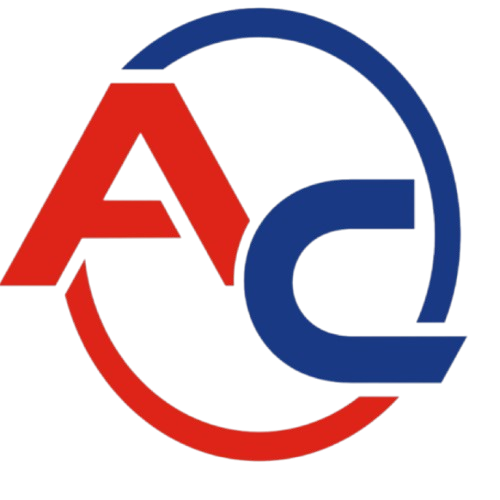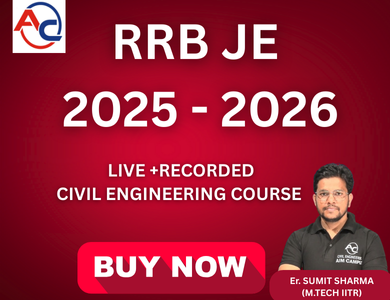Courses
RRB JE
Exam Details
Syllabus
- General Science
- Mathematics
- General Intelligence & Reasoning
- General Awareness
- Technical Subjects (Civil, Electrical, Mechanical, Electronics, and Computer Science)
Civil Engineering Syllabus
- Building Materials
- Construction Management
- Surveying
- Soil Mechanics
- Hydraulics
- Structural Engineering
- Transportation Engineering
- Environmental Engineering
RRB JE (Civil) Course – AIM CAMPUS Roorkee Crack RRB JE with a structured, exam-focused program led by Sumit Sir (M.Tech, IIT Roorkee; 10+ years’ teaching experience). Get complete coverage for CBT-1 & CBT-2, daily practice, and outcome-driven mentorship—designed to finish the syllabus on time and boost your score.
ive + Recorded Classes (replay anytime, speed control) 🎥 CBT-1 Coverage: Mathematics, Reasoning, General Awareness CBT-2 (Civil) Coverage: Building Materials, SOM, RCC, Steel, Surveying, Geotech, FM/Hydraulics, Environmental, Highway/Railway, Irrigation/WRD, Estimation & Construction Topic-wise Notes & Formula Sheets (exam ready)
RRB JE CBT 1 Syllabus 2025
Mathematics
- Simplification
- Number System
- Ratio and Proportion
- Average
- LCM and HCF
- Percentage
- Profit and Loss
- Discount
- Time and Work
- Pipes and Cisterns
- Time and Distance
- Probability
- Trigonometry
- Simple and Compound Interest
- Age-Based Questions
- Mensuration
- Algebra
- Algebra
- Statistics
General Intelligence and Reasoning
- Analogies and Classification
- Coding-Decoding
- Series
- Blood Relation
- Direction Sense
- Seating Arrangement
- Syllogism
- Para Jumbling
- Data Sufficiency
- Clock and Calendar
- Statement and Arguments
- Mathematical Reasoning
- Counting of Figures
- Embedded Figures
- Paper Cutting and Folding
- Non-Verbal Reasoning
General Awareness
- Geography
- History
- Polity
- Economics
- Computer
- Arts and Culture
- Awards and Honors
- Science and Technology
- Famous Personalities
- Sports
- Current Affairs
General Science
- Physics
- Chemistry
- Biology
RRB JE CBT 2 Syllabus 2025
General Science
- Current Affairs
- Indian History and Culture
- Freedom Struggle
- Geography of India
- Indian Polity and Constitution
- Economy of India
- Sports
- Science and Technology
- Awards & Honors
- Prominent Personalities
Physics and Chemistry
- Basic Concepts
- Mechanics
- Work, Energy, and Power
- Gravitation
- Properties of Matter
- Thermodynamics
- Optics
- Waves and Oscillations
- Electricity and Magnetism
- Chemical Reactions
- Atomic Structure
- Periodic Table
- Chemical Bonding
- Molecular Structure
- States of Matter
- Chemical Equilibrium
- Organic Chemistry
- Environmental Chemistry
Basics of Computers and Applications
- Introduction to Computer
- Generations of Computer
- Input and Output Devices
- Operating System
- Networking
- Computer Virus
- Computer Hardware and Software
- Programming Language
- MS Word
- MS Excel
Basics of Environment and Pollution Control
- Basics of Environment
- Environmental Pollution
- Types of Pollution
- Waste Management System
- Acid Rain
- Ozone Layer Depletion
- Global Warming
- Environmental Problems
Engineering Mechanics
Force (resolution of force, moment of force, force system, composition of forces), Equilibrium, Friction, Centroid and Center of gravity, Simple machines.
Building Construction
Building components (substructure, superstructure), type of structure (load bearing, framed and composite structures).
Building Materials Masonry materials (stones, bricks, and mortars), Timber, and miscellaneous materials (glass, plastic, fiber, aluminum steel, galvanized iron, bitumen, PVC, CPVC, and PPF).
Construction of Substructure
job layout, earthwork, foundation (types, dewatering, coffer dams, bearing capacity). Building Finishes Floors (finishes, process of laying), walls (plastering, pointing, painting) and roofs (roofing materials including RCC). Building Maintenance Cracks (causes, type, repairs- grouting, guniting, epoxy etc.), settlement (causes and remedial measures), and re-baring techniques.
Building Drawing
Properties of various types/grades of cement, properties of coarse and fine aggregates, properties of concrete (water-cement ratio, properties of fresh and hardened concrete), Concrete mix design, testing of concrete, quality control of concrete (batching, formwork, transportation, placing, compaction, curing, waterproofing), extreme weather concreting and chemical admixtures, properties of special concrete (ready mix, RCC, pre-stressed, fiber reinforced, precast, high performance).
Concrete Technology
Conventions (type of lines, symbols), planning of building (principles of planning for residential and public buildings, rules and byelaws), drawings (plan, elevation, section, site plan, location plan, foundation plan, working drawing), perspective drawing.
Surveying
Types of survey, chain and cross staff survey (principle, ranging, triangulation, chaining, errors, finding area), compass survey (principle, bearing of line, prismatic compass, traversing, local attraction, calculation of bearings, angles and local attraction) leveling (dumpy level, recording in level book, temporary adjustment, methods of reduction of levels, classification of leveling, tilting level, auto level, sources of errors, precautions and difficulties in leveling), contouring (contour interval, characteristics, method of locating, interpolation, establishing grade contours, uses of contour maps), area and volume measurements, plane table survey (principles, setting, method), theodolite survey (components, adjustments, measurements, traversing), Tacheometric survey, curves (types, setting out), advanced survey equipment, aerial survey and remote sensing.
Computer
Aided Design CAD Software (AutoCAD, Auto Civil, 3D Max, etc.), CAD commands, generation of the plan, elevation, section, site plan, area statement, 3D view.
Geo Technical Engineering
Application of Geo-Technical Engineering in the design of foundations, pavement, earth retaining structures, earthen dams, etc., physical properties of soil, permeability of soil and seepage analysis, shear strength of soil, bearing capacity of the soil, compaction and stabilization of soil, site investigation and subsoil exploration.
Hydraulics
properties of fluid, hydrostatic pressure, measurement of liquid pressure in pipes, fundamentals of fluid flow, flow of liquid through pipes, flow through open channels, flow measuring devices, and hydraulic machines.
Irrigation Engineering
Hydrology, investigation and reservoir planning, percolation tanks, diversion head works.
Mechanics of Structures
Stress and strain, shear force and bending moment, moment of inertia, stresses in beams, analysis of trusses, strain energy.
Theory of Structures Direct and bending stresses, slope and deflection, fixed beam, continuous beam, moment distribution method, columns.
Design of Concrete Structures Working Stress method, Limit State method, analysis, and design of singly reinforced and doubly reinforced sections, shear, bond and development length, analysis and design of T Beam, slab, axially loaded column, and footings.
Design of Steel Structures
Types of sections, grades of steel, strength characteristics, IS Code, Connections, Design of tension and compression members, steel roof truss, beams, and column bases.
Transportation Engineering
Railway Engineering (alignment and gauges, permanent way, railway track geometrics, branching of tracks, stations and yards, track maintenance), Bridge engineering (site selection, investigation, parts of bridge, permanent and temporary bridges, inspection and maintenance), Tunnel engineering (classification, shape and sizes, tunnel investigation and surveying, method of tunneling in various strata, precautions, equipment, explosives, lining and ventilation).
Highway Engineering
Road Engineering, investigation for road projects, geometric design of highways, construction of road pavements and materials, traffic engineering, hill roads, drainage of roads, maintenance and repair of roads.
Environmental Engineering Environmental pollution and control, public water supply, domestic sewage, solid waste management, environmental sanitation, and plumbing.
Advanced Construction
Techniques and Equipment Fibers and plastics, artificial timber, advanced concreting methods (under water concrete, ready mix concrete, premix concreting, special concretes), formwork, prefabricated construction, soil reinforcing techniques, hoisting and conveying equipment, earth moving machinery (exaction and compaction equipment), concrete mixers, stone crushers, pile driving equipment, working of hot mix bitumen plant, bitumen paver, floor polishing machines.
Estimating and Costing
Types of estimates (approximate, detailed), mode of measurements and rate analysis. Contracts and Accounts Types of engineering contracts, Tender and tender documents, payment, and specifications.

